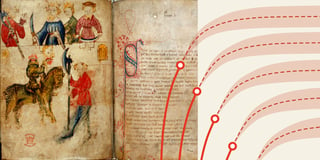How historic vaccination research paved the way for the COVID-19 vaccine
Hi, this is Mirko, co-founder and chairman at Datawrapper. Like you, I’ve spent the last year not going to an office, staying home most of the time, heavily reducing contact to others. Thankfully, there is an end in sight: COVID-19 vaccines are available now. I wonder, though: Do we appreciate enough that we are witnessing the fastest development of finding and producing vaccines in history, by far? Let’s explore history.
The COVID-19 vaccine marks a record: Never before was a vaccine found, tested, and licensed in such a short time.
The long struggle towards vaccines and public health
But getting to such a fast process took centuries. Historically, there were two main challenges: First building knowledge, then finding support.
Medical knowledge formed slowly based on observation and experimentation, driven by pioneering women and men. Some of them never learned that they were right. Because through the centuries, with some regularity, their findings were often not accepted. Instead, they encountered a pattern of doubt, disbelief, and rejection.
Only on occasion there were breakthroughs. One example: In May 1796, the English doctor Edward Jenner inoculated an 8-year-old boy with matter from cowpox and later tested whether the patient was now sheltered against the much more dangerous smallpox. This is how “vaccines” got their name, from the Latin word for cow (vacca).
This particular insight – that some diseases could be prevented through a mild exposure – was known in China and Africa long before. As early as 1718, eighty years before Jenner, the British Lady Mary Wortley Montagu learned about the practice of preventing smallpox when visiting Turkey. “Despite resistance from the medical establishment,” she had her four-year-old son inoculated.
This pattern of slow discovery and even slower acceptance of new findings continued. In the 19th century, the world experienced several heavy outbreaks of Cholera, with millions of people dying.
John Snow was a doctor in England who had experience treating patients from previous cholera outbreaks in the UK. In 1854, he tried something new. He collected data and created the now-famous “cholera map”. Based on his examination, he suspected that the disease occurred “when people ingested certain tiny particles in the water.”
Remarkably, in the same year, in Florence, Italy, another scientist by the name of Filippo Pacini even discovered and named those “tiny particles.” He found a comma-shaped bacillus, which he described as Vibrio.

He published his findings, but they were ignored. Even John Snow did not learn what Pacini found. As a result, it took another 30 years until another researcher named Robert Koch found the cholera bacillus for a second time. The first vaccine was used in 1885.
Even then, the work was not finished. Cholera is complex. The need to improve the vaccines resulted in ongoing research. New findings sparked new efforts as late as in the 1980s and 1990s.
And, amazingly, it took until 1965, 82 years after the death of Pacini, until he was credited for his work. That year, “Vibrio cholerae Pacini 1854” was adopted as the correct name for the cholera-causing organism.
How many lives could have been saved if both medical knowledge and public support acceptance would have evolved faster? Because: Once vaccines are introduced, the number of cases usually falls significantly, sometimes to zero patients.
No guarantee for finding something
Looking only at the successes neglects the fact that in some other cases no vaccine has been found, despite long and intense research. Malaria, dengue fever, ebola and AIDS can not be cured entirely up to this day.
Finding the causes of diseases and developing vaccines is an ongoing challenge. The development of several COVID vaccines in such a short time marks a notable advance. But it was not an “overnight miracle”, because researchers had laid the foundations based on decades of work.
What is needed to do better?
- Diseases have become preventable, ,,but globally 13,5 million children have not been vaccinated” (2018)
- Transparent, clear, and complete information is as important as the research. Only well formed information can help to overcome doubts, to gain acceptance, and to counter misinformation.
- We need to better organize the information we have. Today finding information is no longer the challenge; now it is to filter what is there to get to the core of what is correct and relevant.
One decisive act of John Snow back in 1854, was to remove the handle of a water pump in Broad Street, based on his observations and belief that contaminated water led to people getting ill. In England, up to this day, there is the “Annual Pumphandle Lecture”, by members of the John Snow Society. As a ritual, they remove and replace a water pump handle, as a symbol for the continuing challenges for advances in public health.
Data choices
Historical data should be handled with care. The main challenge when looking at the history of diseases is that there is no consistent data. Usually, one can only find partial data for some diseases and some countries. Estimates are common and must be labeled as such. Show the trend. Show the gaps. Avoid the impression of accuracy through numbers with digits if much of what we have is based on estimates.
Another challenge is the search for historical data. For many topics, such information is scattered, often partial, often just covering a specific period. There is work to do here - to better gather, structure and filter data already there.
A great site demonstrating how this can be achieved is “Our World in Data”, initiated by Max Roser, providing “research and data to work against the world's largest problems”. It is remarkable how many topics can now be investigated from a data angle there. The work done by the team at OWID - from finding to preparing and sharing the data - is invaluable. For the charts above, I used Our World in Data as a starting point.
The history of vaccination is full of stories, of women and men who stubbornly asked for new answers. If you are curious to learn more about some of them, I can recommend the resources below. Next week, our basemap expert Anna will take us on a tour to Sweden with us. See you then!
Resources
- Timeline: History of vaccines: very rich source with many examples and sources
- Mapping Disease: John Snow and Cholera (Royal College of Surgeons of England)
- Robert Koch: One of the founders of microbiology (RKI)
- 8 women who made modern vaccines work (One.org)



